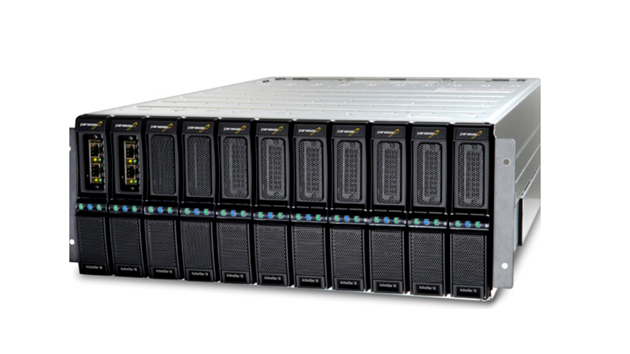Designed for Parallel Performance, High Storage Density, and Fast Rebuild Times
Storage vendor Panasas put more power into its push into the media and entertainment market today with the announcement of the new ActiveStor 18 scale-out NAS appliance.
The key specs for the ActiveStor 18 are scalability and storage density. With 8 TB drive configurations, Panasas offers linear scalability up to 20PB of capacity (from 181TB per shelf) and 200 GB/sec of system throughput (from 1.5GB/sec per shelf) in a single global namespace. That's a 33 percent increase in density over the ActiveStor 16, the company said, with a 19 percent increase in CPU speed and double the cache. The architecture is a solid-state hybrid, utilizing a 480 GB SSD optimized for RAID 6+ in each storage blade, alongside two 8 TB Western Digital HGST He8 Helium-filled hard drives.
"We use a hybrid approach in our product, combining the best of both worlds—the cost-per-GB and streaming throughput superiority of hard disk and the small-file and random-IO characteristics of flash," Panasas VP of Product Management Geoffrey Noer told StudioDaily. "That allows us to provide a product that is very strong at mixed workloads with a variety of different types of accesses taking place at the same time."
Panasas is positioning the ActiveStor 18 as an option for VFX and animation facilities with render farms, since the company's DirectFlow protocol supports large numbers of concurrent connections in parallel. Panasas ActiveStor supports Mac OS, Windows and Linux, with the overall best performance coming from Linux workstations that are often favored in VFX environments, Noer said. And Panasas VP of Industry Marketing David Sallak noted that videogame publisher Square Enix has been using Panasas technology for rendering for more than four years.
Panasas also hopes to gain ground in traditional post-production, where facilities are looking for new, larger storage systems as file sizes increase. "We support Avid and Adobe workflow, and we're just getting exposed to customer workflows that use Blackmagic DaVinci Resolve, now that it's been adapted to be an editorial tool competing with Avid and Adobe," Sallak said. "At the front end of the business, we see a lot of complexity. We can help consolidate workflows to a common work area—a NAS with 10-gigabit infrastructure."
While the storage density of the new 8 TB drives is a strong selling point, Noer readily acknowledges that not every post facility or animation studio needs that kind of capacity out of the gate. "4 TB drives are interesting because many customers aren't looking to get started with 200 TB of storage," he said. "We can minimize the starting price while increasing the amount of performance very well with 4 TB drives. On the flip side, at large studios or large rendering environments where capacity and performance requirements are being targeted, the 8 TB drive makes sense to minimize the overall investment per TB."
| Panasas ActiveStor Pricing | |||
| Configuration | ActiveStor18 181.28TB | ActiveStor 18 90.64TB | ActiveStor 16 134.64TB |
| HDD | 2 x 8TB | 2 x 4TB | 2 x 6TB |
| SSD | 480GB (2.9%) | 240GB (2.9%) | 240GB (2.0%) |
| List Price | $190,000 | $135,000 | $160,000 |
| List Price/GB | $1.05 | $1.49 | $1.19 |
| Source: Panasas | |||
One of the company's key selling points is the fast rebuilds offered by its PanFS operating system and RAID6+, a data-protection level introduced by Panasas in 2014 that is implemented in software rather than in hardware. "That means we can protect data differently based on file size or importance to the end user, but it also means we can spread the data around on the system in a way that diminishes risk as you grow the system," Noer explained. "It also means the rebuilds are a lot faster. In the case of several blocks on a hard drive being unreadable, we have to rebuild only the files that touched those blocks, not the whole drive. And if the drive fails, we have to rebuild only the used space on the drive, not the unused blocks as well. Taking multiple days to rebuild is intolerable."
Panasas is taking orders for the ActiveStor 18 now and expects to begin delivering systems in September.
Did you enjoy this article? Sign up to receive the StudioDaily Fix eletter containing the latest stories, including news, videos, interviews, reviews and more.











Leave a Reply